在半干旱草地上,功能性状在控制生物量生产和分配方面优于植物多样性
IF 6
1区 农林科学
Q1 AGRICULTURE, MULTIDISCIPLINARY
引用次数: 0
摘要
禁牧是恢复退化草原和增强其生态系统服务的关键策略。植物生物量的生产和分配是恢复成功的关键指标,但在放牧排斥条件下,植物功能性状和多样性调控这些动态的机制途径尚不清楚。为了解决这一问题,我们测量了松嫩平原半干旱草地27年的地上(AGB)、地下(BGB)和根冠比(RSR),并研究了植物功能性状和多样性(物种和功能)如何调节这些过程。结果显示,生物量峰值在时间上是分离的,AGB在19岁时达到峰值(491.14 g m⁻²),BGB在15岁时达到峰值(1046.50 g m⁻²)。同时,RSR呈下降趋势,19年后趋于稳定,植物多样性总体呈现与生物量产量相反的趋势。主成分分析确定了放牧排除条件下植物的关键功能策略,其中PC1将资源获取性状(如叶面积、LA)与保守性状(如叶氮含量、LNC)分割,PC2代表以叶干物质含量(LDMC)等性状为主的防御轴。相关分析和变异分配分析表明,功能性状而非多样性成为生物量生产和分配的主要驱动因素。结构方程模型进一步揭示,放牧排斥直接影响AGB和分配,并通过物种丰富度间接调节它们。值得注意的是,放牧通过改变功能性状(LA和LDMC)和LALNC权衡来调节生物量动态。此外,ldmc诱导的功能多样性变化(Rao’s Q)有助于生物量分配调整。我们的研究结果表明,放牧排除下的生物量动态表现出强烈的时间模式,主要由植物功能性状驱动,描绘了关键的机制途径。该框架为评估恢复成功提供了坚实的基础,并为半干旱草原的优化管理提供了战略指导。本文章由计算机程序翻译,如有差异,请以英文原文为准。
Functional trait outperforms plant diversity in governing biomass production and allocation in semiarid grasslands undergoing grazing exclusion
Grazing exclusion is a key strategy for restoring degraded grasslands and enhancing their ecosystem services. Plant biomass production and allocation are critical indicators of restoration success, yet the mechanistic pathways by which plant functional traits and diversity regulate these dynamics under grazing exclusion remain unresolved. To address this, we measured aboveground (AGB) and belowground biomass (BGB) and root![]() to
to![]() shoot ratio (RSR) across a 27–year chronosequence in semi
shoot ratio (RSR) across a 27–year chronosequence in semi![]() arid grasslands of Songnen Plain, Northeast China, and investigated how plant functional traits and diversity (species and functional) regulate these processes. Results revealed temporally decoupled biomass peaks, with AGB peaking at 19 years (491.14 g m⁻²) and BGB peaking earlier at 15 years (1046.50 g m⁻²). Concurrently, RSR declined initially before stabilizing after 19 years, and plant diversity generally exhibited an opposite trend to biomass production. Principal component analysis identified key plant functional strategies under grazing exclusion, with PC1 partitioning resource–acquisitive traits (e.g., leaf area, LA) from conservative traits (e.g., leaf nitrogen content, LNC) and PC2 representing a defense axis dominated by traits such as leaf dry matter content (LDMC). Critically, correlation and variation partitioning analyses demonstrated that functional traits, rather than diversity, emerged as the dominant driver of biomass production and allocation Structural equation modeling further revealed that grazing exclusion directly impacted AGB and allocation, and indirectly regulated them via species richness. Notably, grazing exclusion modulated biomasses dynamics by altering functional traits (LA and LDMC) and LA
arid grasslands of Songnen Plain, Northeast China, and investigated how plant functional traits and diversity (species and functional) regulate these processes. Results revealed temporally decoupled biomass peaks, with AGB peaking at 19 years (491.14 g m⁻²) and BGB peaking earlier at 15 years (1046.50 g m⁻²). Concurrently, RSR declined initially before stabilizing after 19 years, and plant diversity generally exhibited an opposite trend to biomass production. Principal component analysis identified key plant functional strategies under grazing exclusion, with PC1 partitioning resource–acquisitive traits (e.g., leaf area, LA) from conservative traits (e.g., leaf nitrogen content, LNC) and PC2 representing a defense axis dominated by traits such as leaf dry matter content (LDMC). Critically, correlation and variation partitioning analyses demonstrated that functional traits, rather than diversity, emerged as the dominant driver of biomass production and allocation Structural equation modeling further revealed that grazing exclusion directly impacted AGB and allocation, and indirectly regulated them via species richness. Notably, grazing exclusion modulated biomasses dynamics by altering functional traits (LA and LDMC) and LA![]() LNC trade
LNC trade![]() off. Additionally, LDMC
off. Additionally, LDMC![]() induced shifts in functional diversity (Rao's Q) contributed to biomass allocation adjustments. Our findings establish that biomass dynamics under grazing exclusion exhibit strong temporal patterns primarily driven by plant functional traits, delineating key mechanistic pathways. This framework provides a robust basis for assessing restoration success and strategically guides optimal management of semi
induced shifts in functional diversity (Rao's Q) contributed to biomass allocation adjustments. Our findings establish that biomass dynamics under grazing exclusion exhibit strong temporal patterns primarily driven by plant functional traits, delineating key mechanistic pathways. This framework provides a robust basis for assessing restoration success and strategically guides optimal management of semi![]() arid grasslands.
arid grasslands.
求助全文
通过发布文献求助,成功后即可免费获取论文全文。
去求助
来源期刊

Agriculture, Ecosystems & Environment
环境科学-环境科学
CiteScore
11.70
自引率
9.10%
发文量
392
审稿时长
26 days
期刊介绍:
Agriculture, Ecosystems and Environment publishes scientific articles dealing with the interface between agroecosystems and the natural environment, specifically how agriculture influences the environment and how changes in that environment impact agroecosystems. Preference is given to papers from experimental and observational research at the field, system or landscape level, from studies that enhance our understanding of processes using data-based biophysical modelling, and papers that bridge scientific disciplines and integrate knowledge. All papers should be placed in an international or wide comparative context.
 求助内容:
求助内容: 应助结果提醒方式:
应助结果提醒方式:


